By Jennifer L. Patin
August 4, 2016
To download and print this brief, click here.
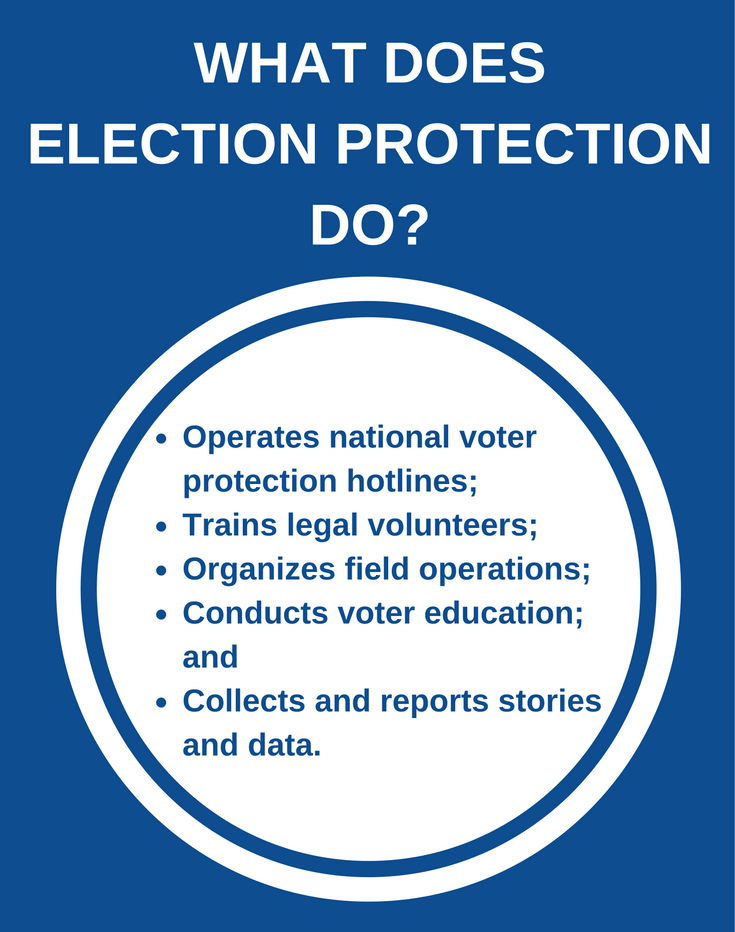 Election Protection, the nation’s largest nonprofit voter protection coalition, is working to advance and defend the right to vote in the first presidential election year without the full protections of the Voting Rights Act of 1965 (VRA). We have already received over 22,000 calls from voters, poll workers, volunteer poll monitors, and election officials via the 866-OUR-VOTE hotline, operated by the Lawyers’ Committee for Civil Rights Under Law (Lawyers’ Committee). And by way of the 866-OUR-VOTE hotline, we have learned a great deal about voters’ experiences since the start of this year’s presidential election season. This report presents a broad review of the 2016 primaries and an overview of voters’ concerns and the problems they faced across the U.S. electoral system, particularly in states formerly covered by Section 5 of the VRA. We feature several voters and give detailed accounts of their primary election experiences. Their stories speak to Election Protection’s comprehensive efforts to help voters by troubleshooting problems with local and state election officials, and poll workers and advocates. Our report illustrates the American voter’s strong will to cast a ballot that counts and highlights the unique and systemic problems that characterize this nation’s electoral process.
Election Protection, the nation’s largest nonprofit voter protection coalition, is working to advance and defend the right to vote in the first presidential election year without the full protections of the Voting Rights Act of 1965 (VRA). We have already received over 22,000 calls from voters, poll workers, volunteer poll monitors, and election officials via the 866-OUR-VOTE hotline, operated by the Lawyers’ Committee for Civil Rights Under Law (Lawyers’ Committee). And by way of the 866-OUR-VOTE hotline, we have learned a great deal about voters’ experiences since the start of this year’s presidential election season. This report presents a broad review of the 2016 primaries and an overview of voters’ concerns and the problems they faced across the U.S. electoral system, particularly in states formerly covered by Section 5 of the VRA. We feature several voters and give detailed accounts of their primary election experiences. Their stories speak to Election Protection’s comprehensive efforts to help voters by troubleshooting problems with local and state election officials, and poll workers and advocates. Our report illustrates the American voter’s strong will to cast a ballot that counts and highlights the unique and systemic problems that characterize this nation’s electoral process.
Working Toward Better Processes for Voters and Election Officials
The problems reported to Election Protection in the 2016 primary season underscore the necessity for eliminating restrictive voting laws that often create discriminatory barriers to the ballot, as well as implementing thoughtful election administration plans and year-round voter education.
Calls to 866-OUR-VOTE reveal the impact that restrictive state voting laws and exclusionary electoral practices have had on the voter experience. For example, a number of voters in Texas reported problems voting or disenfranchisement due to the state’s strict photo ID law. While the Fifth Circuit Court of Appeals recently ruled that the Texas photo ID law had a discriminatory effect on voters, the law was in effect for the March 1, 2016 Texas primary. In Florida, voters with past felony convictions reported frustration with navigating the rights restoration process. Unaffiliated voters were confused by the partisan rules that prevented them from voting in closed primaries and caucuses, while other voters were mistakenly identified as unaffiliated and therefore blocked from voting regular ballots in some states. In light of the voter experience during the 2016 primaries, Election Protection makes the following broad recommendations:
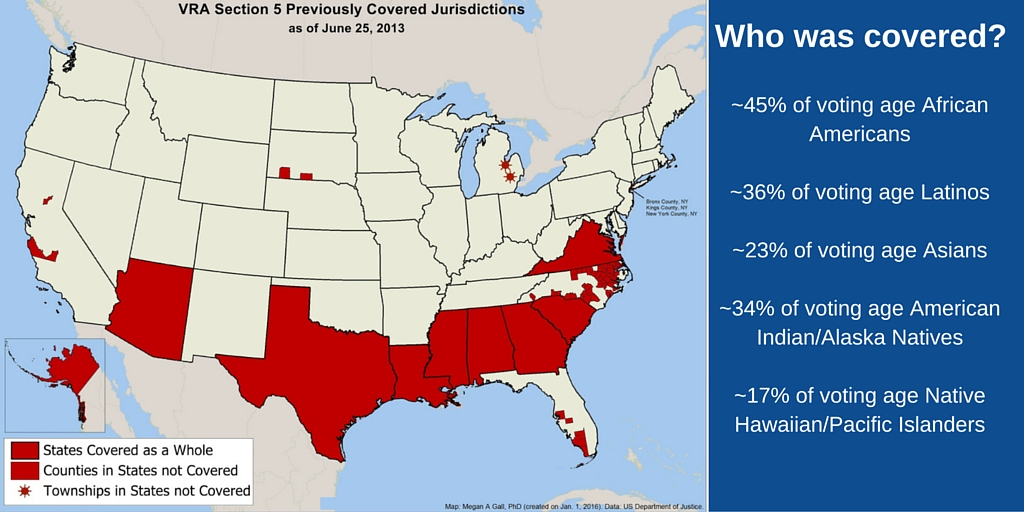
Figure 1: VRA Section 5 Previously Covered Jurisdictions as of June 25, 2013 Dr. Megan A. Gall @DocGallJr
1. Congress must #RestoretheVRA.
On June 25, 2013, voters in 15 states lost protection under Section 5 of the VRA due to the United States Supreme Court decision in Shelby County v. Holder. Section 5 was not only one of the VRA’s key tools for preventing discrimination in voting, but it also ensured that communities were notified of proposed voting changes and had the opportunity to comment on those changes before they were implemented. While Congress stalls on two pending bills that could strengthen the VRA, the impact of the Shelby County v. Holder decision is palpable. The problems reported to Election Protection throughout the primary season expose the value of Section 5. For example, under Section 5, the U.S. Department of Justice would have thoroughly reviewed the precinct and polling place consolidations and reductions that detrimentally impacted primary voters in Arizona and Georgia before the states implemented those decisions. The public would have been notified of the plans, and the federal government would have sought the potentially impacted communities’ input. Even with recent court victories, 15 states will have new restrictions on voting rights in effect for the November 8, 2016 general election. Seven of those 15 states were covered by Section 5 of the VRA.
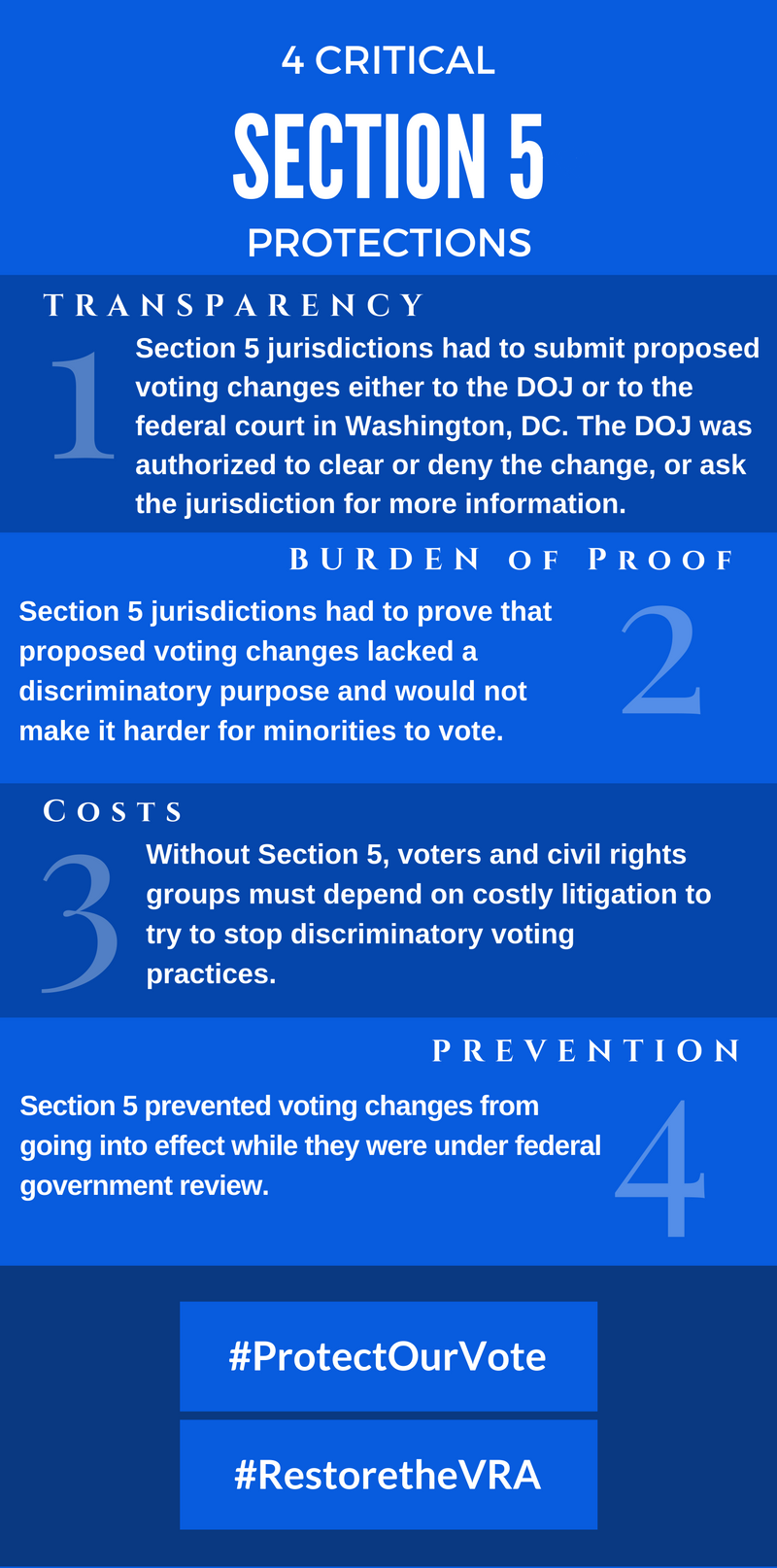
The Shelby County Effect on the DOJ Federal Observer Program
On July 15, 2016, U.S. Attorney General Loretta Lynch announced a massive reduction in the U.S. Department of Justice’s federal observer program because of the Shelby County v. Holder decision. Previously, the U.S. Attorney General had the authority to send federal observers to Section 5 covered areas. Attorney General Lynch has now stated that the DOJ will no longer dispatch observers without a court order. For the 2016 presidential election, the DOJ will send federal observers to just five states, signifying the smallest deployment of observers since the VRA took effect. The massive reduction of the federal observer program expands the burden placed on voters to look out for and speak up against vote suppression efforts that make it harder for people to access the ballot box in their communities. Election Protection will work hard to fill the void in poll monitors left by the new plan. The Shelby County effect is becoming more evident. Congress must take urgent steps to refortify the federal government’s ability to prevent vote discrimination.
2. Secretaries of State’s offices across the nation must work with county election officials to develop and use solid Election Administration Plans.
In the 2016 primary season, common election administration-related problems included ballot shortages, malfunctioning voting equipment, inefficient curbside voting, and poll worker misinformation e.g. provisional ballot voting and inattention to essential details e.g. proper signage. Election Administration Plans (EAPs) help make sure that election officials are prepared to hold elections and decrease the likelihood of unforeseen problems, while increasing their capacity to plan for and resolve snafus. EAPs were ordered in Ohio as a result of the lawsuit League of Women Voters v. Brunner, filed by the Lawyers’ Committee and others in 2005 following the problems that plagued Ohio’s 2004 election. The suit alleged that Ohio’s method of administering elections violated voters’ constitutional rights. As a main part of the 2009 settlement, each county had to create and submit an EAP to the Ohio Secretary of State that included the following topics: resource allocation; data security; Election Day communication; education materials and ballots; Election Day contingency plans; poll worker recruitment, training, and accountability; voter registration; absentee ballots; and a master calendar of relevant electoral dates. On March 30, 2016, the Lawyers’ Committee, Election Protection partners Arizona Advocacy Network and League of Women Voters of Arizona, and local voting rights allies One Arizona and Promise Arizona sent a letter to the Arizona Secretary of State’s office requesting that counties develop and submit EAPs to prevent the extremely long lines that voters faced in Arizona’s presidential preference election. These plans would set out a solid emergency action plan, enabling counties to respond to technological failures, unexpected long lines, and other unforeseen problems during elections. Election Protection strongly urges all secretaries of state and county election officials to prioritize EAP development.
3. Voters can take steps to be ready to vote.
 Election Protection volunteers provided numerous voters with basic who, what, when, where, why, and how information e.g. Who are the candidates? What do I need to bring to the polls to vote? When does my polling place open/close? Where is my polling place? Why do I have to show photo ID? How do I update my voter registration? Election officials must support voter empowerment by giving voters clear information on how to meaningfully participate in the electoral process and by having conversations with voters about improving election administration.
Election Protection volunteers provided numerous voters with basic who, what, when, where, why, and how information e.g. Who are the candidates? What do I need to bring to the polls to vote? When does my polling place open/close? Where is my polling place? Why do I have to show photo ID? How do I update my voter registration? Election officials must support voter empowerment by giving voters clear information on how to meaningfully participate in the electoral process and by having conversations with voters about improving election administration.
Along with calling for clarity from election officials, Election Protection offers several ways that will help prepare voters to vote:
- Plan to vote—Register to vote and make sure your voter registration is up-to-date. Plan your trip to the polls well ahead of any election, including scheduling voting into your work day, if necessary. Arrange transportation to the polls for yourself or organize a carpool. Find out if you have access to early voting. Know your polling place location in advance, and check with your county Board of Elections for polling place changes 1-3 days before voting.
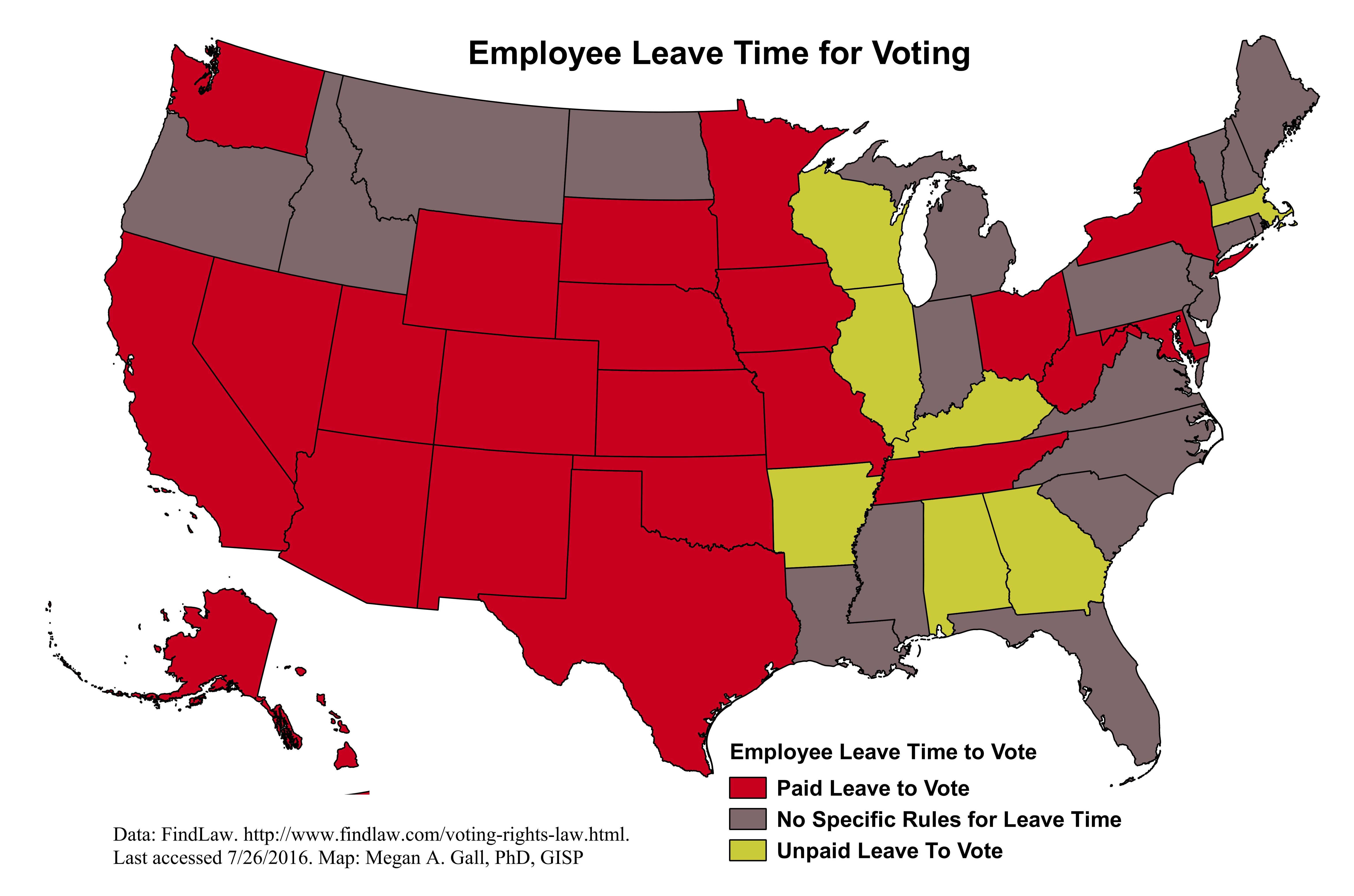
- Double-check the details—The rules are constantly changing due to states’ actions and developing litigation. Find out your state’s important dates, like deadlines for registering to vote and requesting an absentee ballot. Know what types of ID are required to register and to vote.
- Report the problems—It is difficult to predict where and when problems will arise. Be the eyes and ears of your community, and report changes that could make it harder to vote. The sooner Election Protection learns of these voting changes, the more likely it is that we can address the problems before Election Day. A voting problem does not have to become a voting barrier.
- Ask for help—When election officials and poll workers fall short of providing clear answers or solutions to voting problems, do not let confusion stop you from having a voice. Call 866-OUR-VOTE.
At all times, voters can:
- learn about local candidates and ballot measures, and vote in local elections;
- initiate conversations about having a voice in choosing the people who make important decisions that impact local communities;
- attend meetings of election officials that are open to the public;
- encourage friends and family to register to vote and learn more about the voting process; and
- advocate for additional civic engagement classes and activities in schools, colleges, and communities.
2016 State Primary Snapshots
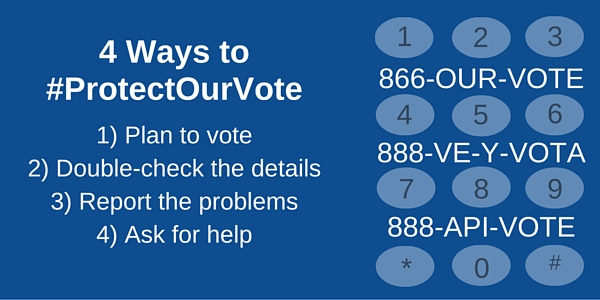 In addition to the recommendations above, Election Protection encourages voters to memorize its voter protection hotline numbers. For the 2016 general election in November, Election Protection will operate all three of its hotlines to make sure voters get answers to their questions and help with any problems. The hotlines include: the Lawyers’ Committee’s 866-OUR-VOTE, the National Association of Latino Elected Officials’ 888-VE-Y-VOTA for bilingual English/Spanish assistance, and Asian and Pacific Islander American Vote and Asian Americans Advancing Justice|AAJC’s 888-API-VOTE for help in English and Asian languages. In the 2016 primary season, the Lawyers’ Committee’s 866-OUR-VOTE went live for primaries in 34 states. The following section gives a snapshot of the areas formerly covered by Section 5 of the VRA, i.e. statewide and county-wide voting problems, selected election administration and litigation updates, and real voter and Election Protection volunteer stories, to paint a picture of our presidential election year so far. The listed incidents depict some of the problems that compel callers to contact Election Protection. The descriptions of these selected incidents in 10 states—Alabama, Arizona, California, Florida, Georgia, Louisiana, New York, North Carolina, Texas, and Virginia—present the perceptions and experiences of 866-OUR-VOTE callers and the Election Protection volunteers that helped them.
In addition to the recommendations above, Election Protection encourages voters to memorize its voter protection hotline numbers. For the 2016 general election in November, Election Protection will operate all three of its hotlines to make sure voters get answers to their questions and help with any problems. The hotlines include: the Lawyers’ Committee’s 866-OUR-VOTE, the National Association of Latino Elected Officials’ 888-VE-Y-VOTA for bilingual English/Spanish assistance, and Asian and Pacific Islander American Vote and Asian Americans Advancing Justice|AAJC’s 888-API-VOTE for help in English and Asian languages. In the 2016 primary season, the Lawyers’ Committee’s 866-OUR-VOTE went live for primaries in 34 states. The following section gives a snapshot of the areas formerly covered by Section 5 of the VRA, i.e. statewide and county-wide voting problems, selected election administration and litigation updates, and real voter and Election Protection volunteer stories, to paint a picture of our presidential election year so far. The listed incidents depict some of the problems that compel callers to contact Election Protection. The descriptions of these selected incidents in 10 states—Alabama, Arizona, California, Florida, Georgia, Louisiana, New York, North Carolina, Texas, and Virginia—present the perceptions and experiences of 866-OUR-VOTE callers and the Election Protection volunteers that helped them.
Alabama
#SuperTuesday voters in Alabama: Your voter info site is down but we have already alerted the state and they are fixing. Should be up soon!
— Election Protection (@866OURVOTE) March 1, 2016
Statewide: Website malfunction
People in at least five different Alabama counties reported that the state and county polling place locator websites were down.
Election Administration Update: Online Voter Registration
Alabama launched online voter registration in February 2016. Alabamans can go to Alabama Votes to apply for or update their voter registration.
Arizona
Statewide: Voter registration confusion, vote denial
Voters who had either registered to vote as party-affiliated on the state’s website for the 2016 primary or who had always been party-affiliated reported that poll workers told them they could not vote because they were listed as “unaffiliated.” Election Protection received calls from voters in Maricopa and Pima Counties about this large-scale problem. Read more here and here.
Maricopa County: Long lines, poll worker misinformation/misconduct, vote denial
- Voters throughout Maricopa County reported long wait times to vote, ranging from 1.5 hours to over 5 hours. Some voters stood outside in long lines that were barely moving, and a number of people who could not sustain the heat left without voting.
- Poll workers at multiple locations failed to offer provisional ballots to voters. One voter had recently confirmed his active registration status and presented a tribal ID card to vote. A poll worker refused to accept this form of ID and did not offer the voter a provisional ballot.
- Voters with physical disabilities were impacted by long lines. One disabled voter made two attempts to wait in long lines to vote and eventually left without voting.
- Poll workers told voters that they could not vote and discouraged them from filling out provisional ballots at a polling place in S. 48th St. in Phoenix. One voter waited in line for one hour and 15 minutes to vote, only to be wrongly told that she was not registered.
Litigation Update: Huerena v. Reagan
On June 2, 2016, the Lawyers Committee and pro bono co-counsel filed suit on behalf of Maricopa County voters who were either unable to vote or had to wait in line for many hours to vote in the March 22, 2016 presidential preference election. The suit seeks to avoid a repeat of the long lines and resulting voter disenfranchisement attributed to the county’s decision to reduce the number of polling places from 403 in 2008, to 211 in 2012, to just 60 this year.
California
Statewide: Missing vote-by-mail ballots
What to do if you didn’t get your mail in ballot https://t.co/O7hn8YAogF via @maryplummer pic.twitter.com/qRNXIcpmiX
— 89.3 KPCC (@KPCC) June 7, 2016
Voters in the following counties reported that they applied to receive, but never got a mail-in ballot: Alameda, Contra Costa, Los Angeles, Orange, Sacramento, San Diego, and Santa Clara.
Los Angeles County: Inadequate training, broken machines, late openings, poll worker misinformation/misconduct
- Voters at multiple polling locations in Los Angeles County reported broken machines.
- Poll workers were improperly trained at operating the machines for voters with vision disabilities at a Los Angeles polling place. One voter had to rely on her young child to help her cast a ballot.
- A polling place on E. 118th St. in Los Angeles opened 30 minutes late, and it took even more time for poll workers to set up before voting began.
- A Long Beach polling place opened late and was understaffed. Poll workers gave waiting voters provisional ballots and did not offer them regular ballots.
- Voters at a polling place in the unincorporated community of View Park-Windsor Hills were missing from the voter list even though they were confirmed registered voters. The community is nearly 85 percent African-American.
Orange County: Poll worker misinformation/misconduct
Poll workers gave provisional ballots to voters who had switched their registration from the Democratic Party to the Republican Party.
San Francisco: Poll worker misconduct
Poll workers at precinct 7542 gave a provisional ballot to every person in line around 9 a.m., causing anger and confusion among voters.
Florida
Statewide: Rights restoration process
Voters tried, without success, to navigate Florida’s rights restoration process.
Orange County: Broken machines
Voters called from multiple Orange County locations to report broken machines. One voter reported that the machines used to validate ID were not working, and several people left without voting. A voter at a different precinct reported similar problems with the machines used to scan IDs.
Palm Beach County: Polling place problem
At one point during voting hours, all of the entrances of a Boca Raton polling place were locked.
Volusia County: Understaffed polling place
The county combined two precincts, yet only three poll workers were on-site. The wait time to vote was over an hour. A number of senior citizens had trouble standing up in the long lines.
Georgia
Talked to a voter in Cobb County, Georgia who rec’d no notice about polling site change; he went to new site that was closed. @866OURVOTE
— Kristen Clarke (@KristenClarkeJD) March 2, 2016
Cobb County: Inadequate signage and notice
Multiple voters received no notice about a polling place change, and there was no signage to redirect voters to the correct polling location. Several voters left without voting.
Fulton County: Broken machines, poll worker misinformation/misconduct
- Two of three check-in machines were down while an estimated 80-100 people waited in line at a polling place on Virginia Avenue NE in Atlanta.
- All voting machines were down at precinct 4 on Whitehall Terrace, SW in Atlanta.
- Poll workers wrongly denied voters provisional ballots at multiple Fulton County locations.
- A poll worker wrongly sent a voter to a polling place 227 miles from his correct polling place.
Gwinnett County: Inadequate signage, vote denial
Poll workers removed signs before the polls closed. By the time voters found the polling place, they were told that they could not vote.
Upson County: Poll worker/county employee misinformation/misconduct, vote denial
Poll workers and a county employee at the Thomaston Civic Center told people waiting in line to leave the polling place and come back to vote in an hour.
Rhondalynn’s Story:
“I waited in line…and I encourage[d] people to stay in line.”
Rhondalynn T., an active community advocate with the Thomaston Improvement Association, arrived to vote at the Thomaston Civic Center in Upson County around 4:15 p.m. When she heard someone at the polling site tell voters in line to leave and come back in an hour, she reached out to 866-OUR-VOTE. The Election Protection volunteer who spoke to Rhondalynn learned that she was determined to vote and had asked the apparent poll worker in charge to stop telling people to turn around and come back later. Rhondalynn recalls, “It was my decision to stay in line, [but the wait] deterred a lot of people from voting.” Rhondalynn confirmed that she eventually voted but waited about an hour and fifteen minutes before doing so. She estimated that 30-40 people left without voting after an Upson County employee and poll workers told people to leave and return in an hour. Rhondalynn later said, “I did speak with one of the ladies and they didn’t see anything wrong with telling people that…I saw the deterring of young voters, and I encourage[d] people to stay in line.” 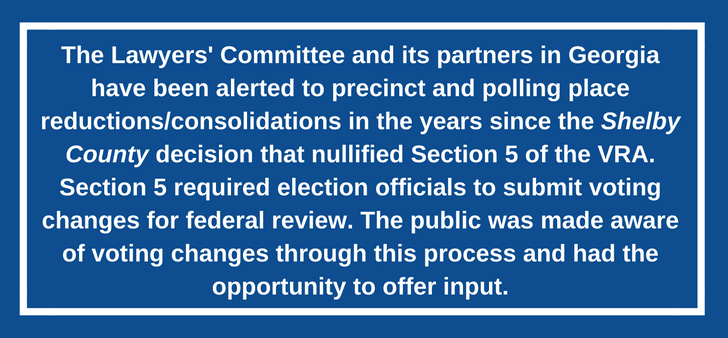 Rhondalynn suspected the confusion might be related to the county’s decision to consolidate local precincts before the 2016 primary election. A Lawyers’ Committee staff member called the Upson County Elections Office twice, both times speaking to the same official. After the second phone call, the county official said the elections office had dispatched Board of Elections members to the Civic Center to assess the problems and determine whether to extend the voting hours there. After following up half an hour later, the Lawyers’ Committee learned that the county had indeed decided to extend voting hours to 8 p.m. and asked local media to spread the word. Rhondalynn ignited the series of phone calls and actions that helped Upson County voters cast meaningful ballots.
Rhondalynn suspected the confusion might be related to the county’s decision to consolidate local precincts before the 2016 primary election. A Lawyers’ Committee staff member called the Upson County Elections Office twice, both times speaking to the same official. After the second phone call, the county official said the elections office had dispatched Board of Elections members to the Civic Center to assess the problems and determine whether to extend the voting hours there. After following up half an hour later, the Lawyers’ Committee learned that the county had indeed decided to extend voting hours to 8 p.m. and asked local media to spread the word. Rhondalynn ignited the series of phone calls and actions that helped Upson County voters cast meaningful ballots.
Fred’s Story:
“They are interested in voting, and we can make this into an activity so they know they’re not forgotten…and they have a right to vote.”
Fred G. of DeKalb County has been helping absentee voters for years. He called 866-OUR-VOTE to explain that he registered 60-70 senior citizens residents in an assisted living community to vote. Fred said, “[W]hen it comes time for an election, some [elderly residents] are very interested in voting, and it’s very difficult to get all of them into a bus, and it’s very difficult for them to be at the polls.” An Election Protection volunteer told Fred where to find the printable absentee ballot request forms on the state’s website. Since Fred is a certified public notary, he was able to check each senior resident’s signature before mailing in the ballots. The Lawyers’ Committee caught up with Fred in July 2016. He recounted that he’d faced no challenges in gathering the absentee ballots for the facility’s elderly eligible voters and had no problems with county election officials. To his knowledge, all of the absentee votes were counted. Fred has since been checking that all eligible residents of the assisted living facility will be registered to vote for the upcoming general election. Fred explains, “They are interested in voting, and we can make this into an activity so they know they’re not forgotten…and they have a right to vote. My motivation is, because they are citizens of the United States, and they are elderly citizens and have paid their dues to the country for their whole lives, I want to let them know that they are still viable, important, and part of the community.”
Great news – Louisiana repeals discriminatory voting law; SPLC to withdraw lawsuithttps://t.co/XQ0eCZ4PBo
— (((SPLC))) (@splcenter) June 1, 2016
Louisiana
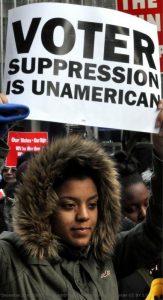 Jefferson Parish: Understaffed precinct
Jefferson Parish: Understaffed precinct
Voters and poll workers were frustrated about an understaffed precinct. Some people left without voting after making multiple attempts to cast a ballot.
Election Administration Update: Proof of citizenship
Election Protection partners, Southern Poverty Law Center and Fair Elections Legal Network (FELN), withdrew a pending federal lawsuit after Louisiana Governor John Bel Edwards repealed a 142-year-old law requiring naturalized citizens to show proof of citizenship when registering to vote.
New York
Kings County: Poll worker misinformation, late openings, voter registration confusion
- Multiple voters called from polling place P.S. 73 on MacDougal St. in Brooklyn. Poll workers told voters that the polling place was closed because the ballots were in a lock box and no one present had the right keys to open it. Poll workers told voters not to wait, and a number of voters left without casting a ballot.
- Multiple voters called from the Williamsburg Community Center polling place on Graham St. in Brooklyn. Poll workers reported technical difficulties and told voters to come back. One voter said about 20 people left without voting. Another voter left around 6:45 a.m. and returned in the evening to vote.
- Voters called from across Kings County to report that they could not vote because they were mistakenly listed as unaffiliated voters. A number of voters challenged their unaffiliated status before election judges at the Kings County Board of Elections. Some were successful, while others left the BOE disenfranchised.
Nassau County: Inadequate signage, no ballots, provisional ballot denial
- Voters complained of inadequate signage around the presidential preference voting area at a polling place in the Village of Lynbrook.
- Poll workers at one location told voters that affidavit ballots had run out and they would not be resupplied that night.
- Poll workers were improperly trained in the provisional voting process at a polling place in the Village of Sea Cliff.
Read more about New York’s April 19, 2016 primary here.
North Carolina
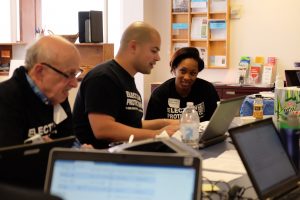 Statewide: Provisional ballot denial
Statewide: Provisional ballot denial
Voters in multiple counties were denied provisional ballots even after there was a lawful “reasonable impediment” that prevented them from presenting an acceptable photo ID to vote.
Carteret County: Poll worker misinformation/misconduct, provisional ballot denial
Poll workers denied provisional ballots to voters who showed up to vote in the wrong precinct.
Durham County: Long lines, computers down, provisional ballot denial
Two of three voting computers were down with at least 50 people in line. Poll workers told people not to vote provisionally.
Guilford County: Poll worker misinformation/misconduct, vote denial
A poll worker turned away voters and told voters that, nine times out of 10, their provisional ballots would not be counted.
Johnston County: Polling place change, inadequate signage, inefficient curbside voting
- Voters did not receive notification of a polling place change in Clayton.
- Cars were parked in the curbside voting area, and poll workers were not responsive when voters pushed the curbside call button at the same polling place on Cleveland Rd. in Clayton.
Litigation Update:
On July 29, 2016, the Fourth Circuit Court of Appeals ruled that several parts of North Carolina’s 2013 law, which contained a number of voter restrictions, were enacted with the intent to discriminate against the State’s Black voters. The Fourth Circuit’s decision restores the 17-day early voting period and same-day registration during early voting, allows preregistration for 16 and 17 year olds and out-of-precinct voting on Election Day for voters in their designated counties, and blocks the voter ID requirement. Election Protection partners Southern Coalition for Social Justice and Advancement Project were two of the groups that led the litigation effort.
Reverend Roger’s Story:
“I felt that…the effort of volunteering was truly worth it.”
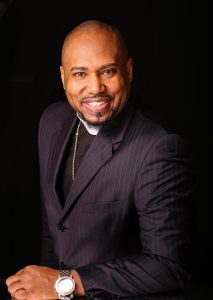 Rev. Roger H. served as an Election Protection volunteer in Forsyth County for the 2016 primaries. He was assigned to the last volunteer shift until the close of voting at 7:30 p.m. Around 7:10 p.m., Rev. Roger remembers a woman arriving to vote with her elderly mother. Although voting was still allowed for 20 minutes, Rev. Roger says the precinct judge had started removing signs and closing up. The woman voted and then asked for curbside assistance for her mother. The poll worker who came to help them asked for her mother’s photo ID, in accordance with North Carolina’s then-law, but told the woman that her mother could not vote because her ID was expired. Rev. Roger overheard the conversation and took action. He thought, “‘Wait a minute. That’s not correct!’ I remembered the actual law that said YES she can vote! Another poll worker [and I] said, ‘That’s not right!’” He remembers the woman saying, “This could be my mother’s last time to be able to vote.” Rev. Roger called 866-OUR-VOTE for support. An Election Protection volunteer reminded Rev. Roger of the relevant North Carolina laws that he’d learned in his volunteer training: Voters over 70 can vote with an expired acceptable photo ID, as long as that ID was unexpired on their 70th birthday. Rev. Roger told the voter’s daughter and recalls that “At this point everything was frantic because everything was closing. I went in and told [the election judge], ‘This lady can vote. Look it up! I know it’s true because I remember it from my training!’” The woman’s 93-year-old mother voted. Rev. Roger admits, “It was, to be honest, a celebratory moment. I felt that the day was truly worth it, and the effort of volunteering was truly worth it. I felt that the system worked despite efforts against people’s right to vote.”
Rev. Roger H. served as an Election Protection volunteer in Forsyth County for the 2016 primaries. He was assigned to the last volunteer shift until the close of voting at 7:30 p.m. Around 7:10 p.m., Rev. Roger remembers a woman arriving to vote with her elderly mother. Although voting was still allowed for 20 minutes, Rev. Roger says the precinct judge had started removing signs and closing up. The woman voted and then asked for curbside assistance for her mother. The poll worker who came to help them asked for her mother’s photo ID, in accordance with North Carolina’s then-law, but told the woman that her mother could not vote because her ID was expired. Rev. Roger overheard the conversation and took action. He thought, “‘Wait a minute. That’s not correct!’ I remembered the actual law that said YES she can vote! Another poll worker [and I] said, ‘That’s not right!’” He remembers the woman saying, “This could be my mother’s last time to be able to vote.” Rev. Roger called 866-OUR-VOTE for support. An Election Protection volunteer reminded Rev. Roger of the relevant North Carolina laws that he’d learned in his volunteer training: Voters over 70 can vote with an expired acceptable photo ID, as long as that ID was unexpired on their 70th birthday. Rev. Roger told the voter’s daughter and recalls that “At this point everything was frantic because everything was closing. I went in and told [the election judge], ‘This lady can vote. Look it up! I know it’s true because I remember it from my training!’” The woman’s 93-year-old mother voted. Rev. Roger admits, “It was, to be honest, a celebratory moment. I felt that the day was truly worth it, and the effort of volunteering was truly worth it. I felt that the system worked despite efforts against people’s right to vote.”
Nadia’s Story:
“I would not hesitate to call [866-OUR-VOTE].”
Nadia R. o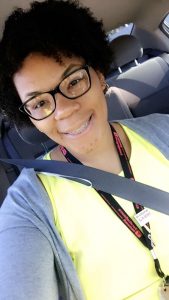 f Cumberland County has used the same ID to vote since high school. She reports that poll workers at her assigned polling place told her that since the address on her ID presented to vote was not the same as her current address, she could not vote. According to North Carolina’s then-voter ID law, the address on the photo ID used for voting does not have to match the voter’s current address. Nadia got wrong information. Instead of becoming discouraged and disenfranchised, she called 866-OUR-VOTE for guidance. Nadia recalls, “I spoke to a lady and an attorney who found me in the system. They were really polite…and let me know that they appreciated my effort in trying to vote and make a difference. If I ever have issues again, I would not hesitate to call the voter hotline.”
f Cumberland County has used the same ID to vote since high school. She reports that poll workers at her assigned polling place told her that since the address on her ID presented to vote was not the same as her current address, she could not vote. According to North Carolina’s then-voter ID law, the address on the photo ID used for voting does not have to match the voter’s current address. Nadia got wrong information. Instead of becoming discouraged and disenfranchised, she called 866-OUR-VOTE for guidance. Nadia recalls, “I spoke to a lady and an attorney who found me in the system. They were really polite…and let me know that they appreciated my effort in trying to vote and make a difference. If I ever have issues again, I would not hesitate to call the voter hotline.”
J.’s Story:
“It was nice to make voting more accessible.”
In partnership with Democracy North Carolina, J. served as an Election Protection volunteer in Johnston County for the March 15, 2016 primary. J. observed a crowd of people who were frustrated about not receiving notification of their polling place change. Voters also expressed that there were no signs at the previous polling location to redirect people. J. believes that some of the voters who left without voting did so because they felt discouraged. J. says, “They had always known before where they were supposed to vote.” J. also observed curbside voters who were not getting help after pressing the call button for assistance with voting, as well as cars parked in curbside voting areas. J. told a poll worker that curbside voting was blocked and that people were waiting to vote. And according to J., the drivers who brought people for curbside voting were not allowed to vote outside with the voter they accompanied to the polls. One curbside voter waited an hour in the heat for his driver to vote. J. did not see the poll workers try to resolve any of the problems, even after observing someone collapse in line. J. called 866-OUR-VOTE. The Election Protection volunteer who spoke with J. contacted the Johnston County Board of Elections. A county official indicated that they would resolve the problems and dispatch someone to make sure the call button for curbside voting was working. J. was an integral part of activating the county BOE’s involvement. In reflection, J. says, “It was nice to be able to…tell people they could have curbside voting. It was nice to make voting more accessible.”
Texas
Busy morning at @866OURVOTE. Polling & voter reg lookups in TX & AL have been down all AM making it hard 2 give voter info. #SuperTuesday
— Chris Melody Fields (@Fieldsy) March 1, 2016
Statewide: Website malfunction
People in multiple Texas counties reported that the state’s polling place locator was down.
Bell County: Ballot shortages
- A polling place on Westcliff Rd. in Killeen ran out of ballots multiple times.
Bexar County: Provisional ballot denial, poll worker misinformation/misconduct, long lines
- A poll worker denied an estimated 10-15 people provisional ballots after telling them that their ballots would not count or be worth it at a San Antonio polling place.
- More than 100 people waited in line at an understaffed and poorly run polling place in San Antonio.
Harris County: Photo ID problems, broken voting machines
- County officials denied a citizen an Election Identification Certificate even though the voter presented an expired US passport, a valid and current out-of-state driver’s license, a social security card, a Texas voter registration card, and a utility bill as proof of Texas residency.
- At a polling place on W. Donovan St. in Houston, half of the voting machines were broken and there was no air conditioning or adequate ventilation.
Tarrant County: Photo ID problems, vote denial
- Voters struggled with the strict Texas photo ID law. One voter could not vote with a federal government photo ID issued by the U.S. Department of Homeland Security.
- When a voter registered with her social security card, an election official told her she could use her out-of-state license to vote. The voter cried at the polling place when poll workers told her she couldn’t vote.
Find out why #votingrights #advocates r celebrating 5th Cir.decision 2 strike down #Texas #VoterID b4 #Election2016 https://t.co/VIvT4JXmyt
— Jennifer L. Patin (@JennyPatDC) July 22, 2016
Litigation Update: Veasey v. Abbott
On July 20, 2016 the full Fifth Circuit Court of Appeals ruled that the Texas photo ID law had a racially discriminatory effect. This was the fourth court to find that the law is racially discriminatory and had a disproportionate impact on African-American and Latino voters in Texas. In its ruling, the Fifth Circuit asked the district court to enforce a remedy. The following remedy for the November 2016 presidential election in Texas was filed on August 3, 2016: a voter without one of the previously required photo IDs can vote a regular ballot by requesting and signing a reasonable impediment form and by presenting copies or originals of a utility bill, bank statement, government check, paycheck or other government document that includes the voter’s name and an address. The address does not have to match the address listed on the voter rolls. As part of the remedy, Texas has committed to voter education efforts and an election worker training plan.
Tyler’s Story:
“EP called me back and said ‘Don’t worry…’”
Tyler H. of Bell County arrived with his wife at their assigned polling place around 6 p.m. The polling place had run out of Democratic primary ballots. Tyler remembers that the poll workers said the location had been out of the ballots for a couple of hours and had turned away 73 people. He recalls that because the polling place was scheduled to close at 7 p.m., “As soon as you stepped in the building and left, you would not [be] let back in.” Tyler says, “My friend messaged me about the [866-OUR-VOTE] hotline and sent me a link with the EP number.” Tyler contacted Election Protection. An Election Protection volunteer took his call and then contacted the Bell County Elections Department. After the volunteer recounted Tyler’s story, someone in the Elections Administrator’s office indicated that ballots were on the way and the people outside would be allowed back in to vote. Tyler explains that, “EP got a hold of the county and made sure that we could…come back.” While Tyler and others were waiting, he recalls that, “EP called me back and said, ‘Don’t worry, they have forms they are printing out, and they are on their way…’ Everyone started cheering because there were 20 or 30 of us just waiting and upset. [We] didn’t want to leave because then [we] didn’t get to vote.” Tyler, and the people waiting with him, got to vote.
Bryce’s Story
Bryce K. arrived to vote at his assigned polling place in Tarrant County. Bryce brought his official federal employment ID for the Transportation Security Administration agency of the U.S. Department of Homeland Security. The restrictive Texas voter ID law in place at the time allowed Texas voters to present only seven kinds of photo ID to vote. This list included a concealed handgun license, but not an employment ID or student ID, among others. Bryce called 866-OUR-VOTE. An Election Protection volunteer helped Bryce understand the state’s voter ID law and the provisional ballot process. The Lawyers’ Committee called him back the day after the March 1 primary to find out if he needed help understanding how to get his provisional ballot to count. In July 2016, the Lawyers’ Committee talked with Bryce again, and he confirmed that his primary vote counted. In addition, the Lawyers’ Committee gave Bryce some good news: the Fifth Circuit found that the very Texas photo ID law that had complicated Bryce’s ability to exercise his right to vote was discriminatory.
It’s #SuperTuesday & the polls are officially open in #Virginia! Problems voting? Call @866OURVOTE #Election2016 #electionprotection
— New VA Majority (@NewVAMajority) March 1, 2016
Virginia
Multiple Counties: Polling place changes
Voters in Prince William County and Norfolk County reported polling place changes without prior notification.
Buckingham County: Poll worker training concerns
An experienced poll worker reported that poll workers in training were being discouraged from telling disabled voters about the American Disability Association-compliant voting device. According to the caller, poll workers were told to do whatever possible to get voters to vote by proxy rather than use the ADA machine.
Litigation Update: Howell v. McAuliffe
On April 22, 2016, Virginia Governor Terry McAuliffe issued an executive order to restore voting rights to more than 200,000 people who have finished their full sentence, including probation and parole. On May 23, attorneys for a group of Virginia Republicans filed suit against Gov. McAuliffe, challenging the executive order as unconstitutional and seeking to cancel it. Several Election Protection coalition partners filed amicus briefs in support of Gov. McAuliffe’s authority to issue the executive order, including the Lawyers’ Committee, the ACLU, Advancement Project, and the FELN, as well as the Virginia State Conference of the NAACP. On July 22, the Supreme Court of Virginia ruled that Gov. McAuliffe’s action violated the state constitution. Virginia election officials announced days later that August 8 is the deadline to revoke the voting rights of those who had registered under Gov. McAuliffe’s order.
Taking Action to Make Voting Easier in November
With the 2016 general election only three months away, it is time for everyone to take action for a better electoral process. For example, the stories shared in this report make clear that poll workers across the country need better training about provisional ballot voting. Election officials in every state can act now to improve poll worker training in that specific area and in other areas. Website glitches contributed to a number of voting problems, indicating that election officials need to thoroughly test their systems before the general election. Voters and voting rights advocates are celebrating recent court decisions, but election officials need to make sure both voters and poll workers have clear information about the election administration changes brought about by these court rulings. And election officials must make plans for executing smooth elections, just as voters must make plans for voting. Voters in Section 5 formerly covered areas need to continue to be diligent, but Congress should work toward taking this burden off of voters by restoring the VRA. Much work remains, but we can all contribute to improving our democracy. Ahead of the November 8, 2016 election, what can you do to #ProtectOurVote?
Jennifer L. Patin is the Writer/Editor for the Voting Rights Project of the Lawyers’ Committee. Special thanks goes to Emma Howard, Washington University of St. Louis ’18, for her notable efforts to collect voter and volunteer stories for this report as an undergraduate intern with the Lawyers’ Committee. Ritika Bhasker volunteered to collect stories, and her efforts are also appreciated.
Election Protection, the nation’s largest nonpartisan voter protection coalition, is led by the Lawyers’ Committee. Through its suite of hotlines—866-OUR-VOTE hotline (866-687-8683) administered by the Lawyers’ Committee, 888-VE-Y-VOTA (888-839-8682) administered by NALEO Educational Fund, and 888-API-VOTE (888-273-8683) administered by APIAVote and Asian Americans Advancing Justice-AAJC—and a dedicated team of trained legal and grassroots volunteers, Election Protection helps all American voters, including traditionally disenfranchised groups, gain access to the polls and overcome obstacles to voting. The coalition has more than 100 partners at the national, state and local levels and provides voter protection services nationwide. For more information about Election Protection and the 866-OUR-VOTE hotline, please visit www.866ourvote.org.

